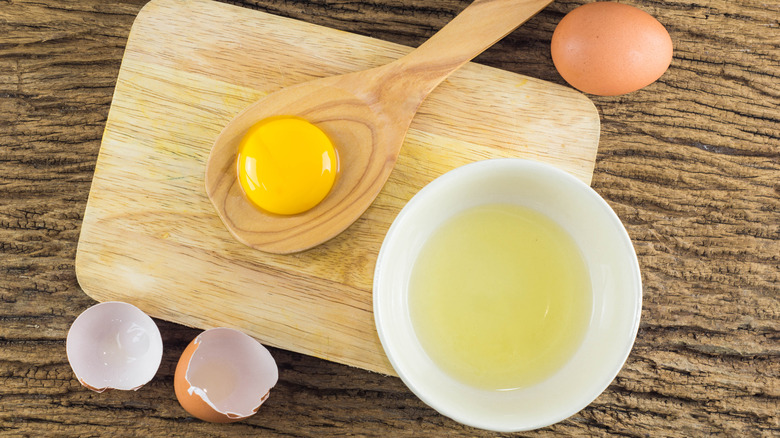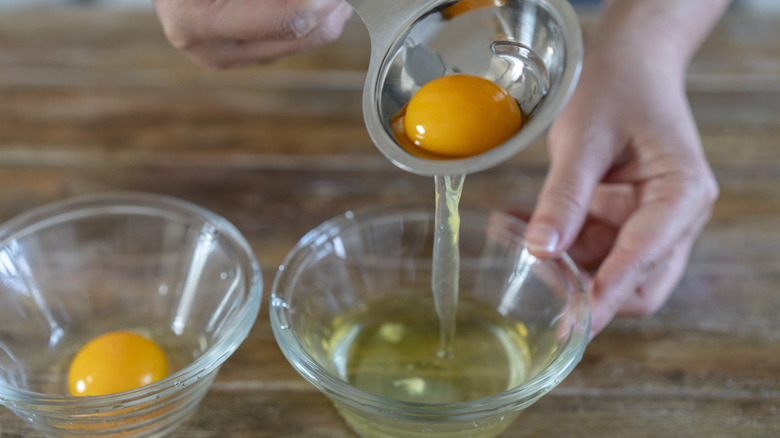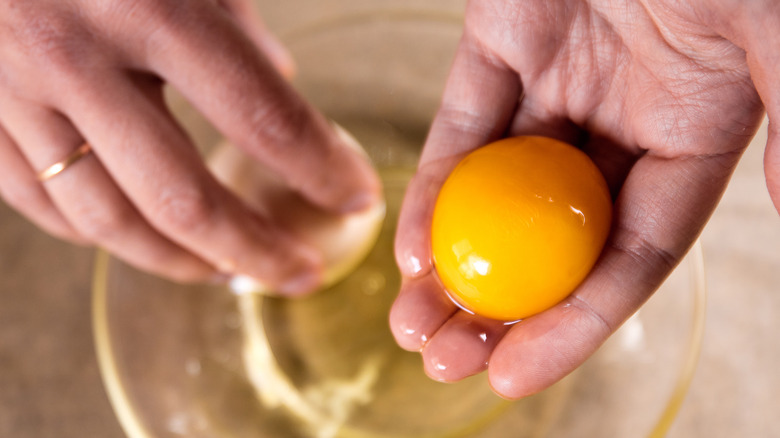The Handy Kitchen Tool That Easily Separates Egg Yolks And Whites
Separating egg yolks and whites is crucial for various recipes — such as custards, meringues, mayonnaise, macarons, crème brûlée, and hollandaise sauce, to name a few. Although it's possible to separate eggs with your hands, the process can be messy and time-consuming, especially if you have multiple eggs to handle. Nothing is more frustrating than trying to remove a slippery an evasive eggshell fragment, or accidentally contaminating your egg whites with yolk just when you think you're almost done.
The good news is that there are specialized kitchen tools designed specifically for separating egg yolks and whites. These gadgets come in a range of designs, and are made from either metal or plastic. One version features a cup attached to a long handle, resembling a small strainer with slits or holes. Others have a round catch that holds the yolk while allowing the white to pass through gaps around the edge. A quirky but effective design is the spider-shaped egg separator, which may look like a Halloween decoration, but works like a charm. Simply hook its plastic legs onto the edge of a bowl and crack the egg into the central depression. The egg whites will flow into the bowl, leaving the intact yolk in the center of the device.
Tools you can use to easily separate eggs
Adding another item to your already cluttered kitchen drawers may not be high on your list of priorities. If you're an avid home baker or personal chef, investing in an egg separator is certainly worth considering. However, if you only dream of making chocolate meringues every once in a while, there are alternative tools that can make egg separation easier.
If you can't get your hands on a spider-shaped egg separator, take a look at your bar cart. A julep-style strainer works well for this purpose, with holes designed to separate ice chips from cocktail liquid and a convenient handle. A slotted spoon with appropriately sized holes or a small strainer can also do the trick, as long as the mesh isn't too fine. You need perforations large enough to let the egg white pass through but not so large that the yolk slips through. Even a funnel can be a useful tool in a pinch; the egg whites will flow through the opening, leaving the yolk behind in the cone.
A disposable plastic water bottle made of flexible material can also be handy. Crack the egg into a bowl, squeeze the empty bottle, and place its opening directly over the yolk. When you release your grip and air is drawn back into the bottle, the yolk will be sucked in as well. Many cute gadgets employ this same suction method for egg separation.
Tips for separating egg yolks and whites
No matter which method or tool you choose, fresh eggs will separate more easily. The membrane that suspends the yolk weakens as eggs age, increasing the likelihood that the yolk will break during separation. Using eggs that are cold rather than at room temperature also helps, as it ensures that the yolk is slightly firmer and easier to separate.
It's important to note that fresh eggs may contain harmful bacteria like salmonella, which can lead to hospitalization in extreme cases; as such, it's crucial to wash your hands, tools, and surfaces that come into contact with raw eggs diligently, as advised by the Food and Drug Administration. Separated raw egg whites can be stored safely for up to four days at temperatures between 35 and 40 degrees Fahrenheit, while separated raw egg yolks can be stored for up to two days. If you don't plan to use them within that time frame, store leftover egg whites for long-lasting use in the freezer. Similarly, if a recipe calls for only egg whites, you can freeze the leftover yolks or try preserving them with salt and sugar.



